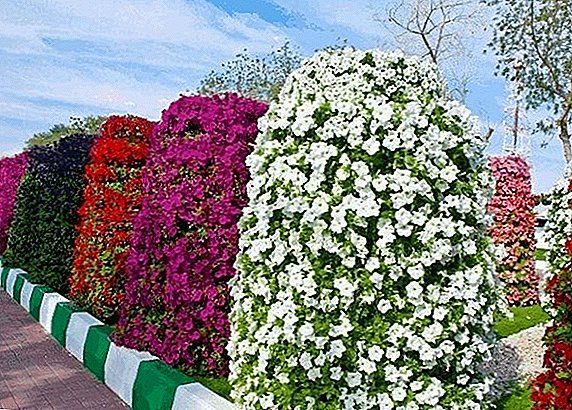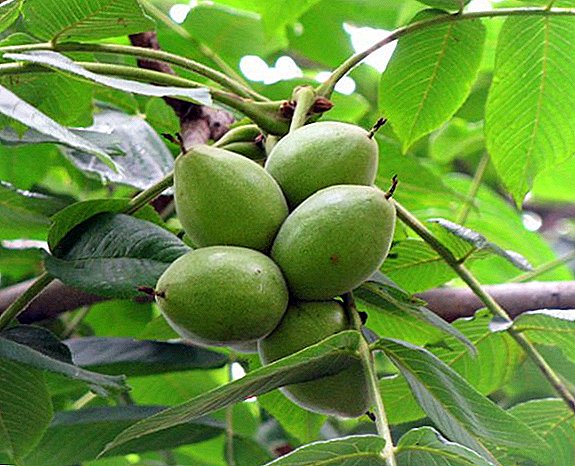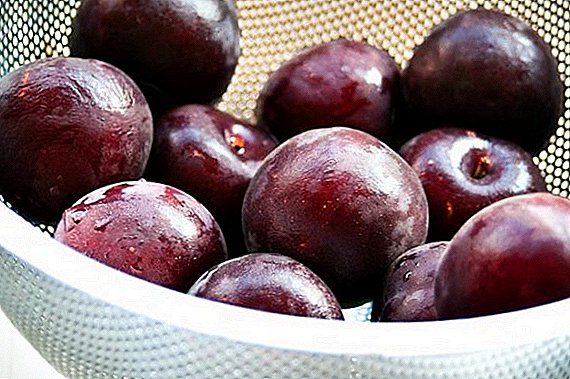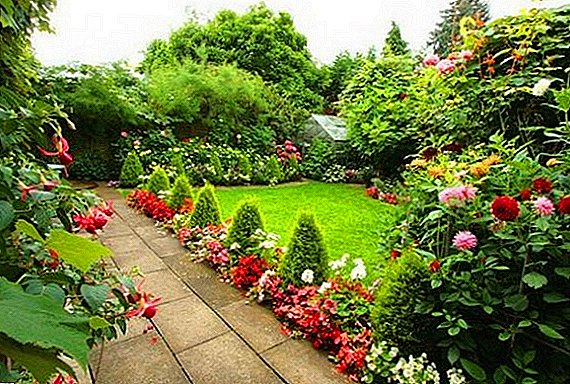 Cottage is a place that allows you not only to grow crops, but also to enjoy nature and relaxation. Each amateur gardener tries to equip the dacha, make it beautiful and unusual. Near the house, many people like to plant small flowers that decorate and create comfort. We offer to understand which border flowers, perennial and undersized, are most often used to decorate the suburban area.
Cottage is a place that allows you not only to grow crops, but also to enjoy nature and relaxation. Each amateur gardener tries to equip the dacha, make it beautiful and unusual. Near the house, many people like to plant small flowers that decorate and create comfort. We offer to understand which border flowers, perennial and undersized, are most often used to decorate the suburban area.
Zhivuchka

This genus of perennial plants can create an incredibly beautiful flower carpet.
Did you know? The most beautiful carpet of creeping tenacity is obtained if the height of the flowers is 15 cm.
The zhivuchka is hardy and unpretentious, so you do not have to spend much time caring for her. The color of the leaves of the flower can be different: sometimes there are dark green leaves, and sometimes purple. The colors depend on the weather conditions and the season. The plant blooms from April to June, it should be planted in sunny areas.
Reproduces survivability by dividing in the autumn period. It is possible to plant a flower in any garden soil.

Zhivuchka tends to grow rapidly on the slopes and between stones, so it is an ideal flower for borders.
If there is little sunlight on the plot, then plant shade-tolerant plants: astilba, aconite, brunner, volzhanka, saxweed, bathing vessel, lupine, roger, host.
This plant will look great with any other flowers. Having planted zhivuchku on the site, you can enjoy its beauty and freshness for a long time.
Dicentra

Dicentra is known to many as a flower with the name "broken heart". Among gardeners the most popular type of bleachers is magnificent. Special care for the bush is not required, but from time to time it is necessary to cut flower stalks and shoots. Any soil can be used for planting - the flower will take root everywhere.
Externally, the center is a lush bush, the height of which is up to 60 cm. One of the advantages of the flower is its durability: it is possible not to replant it up to 8 years.
Flowering is presented in the form of long graceful pink oblate-heart-shaped flowers, whose diameter is about 2 cm. The plant blooms all May, but sometimes the period may shift, depending on the air temperature.

If you want the plant to please you with flowering at the end of the summer season, it is recommended to cut off the old stalks at the end of May, leaving a few young leaves.
Dicenter can be planted in sunny areas and in the shade, as it adapts to any conditions.
Important! Dicentra tolerates cold, however, if you plan to plant a flower in regions where the temperature drops below -30 ° C, for the winter you need to mulch the plant with dry peat up to 8 cm thick.These flowers are ideal for borders and flower beds: perennial plants will delight you for years.
Agapanthus

Agapanthus - very beautiful curb flower, which is often used for landscaping plots. The period of its flowering (from July to September) will allow you to enjoy the refined beauty of the plant for a long time.
Translated from the Greek, "agapanthus" sounds like a "flower of love." It is famous for its tenderness and unearthly beauty.
Best agapanthus will grow away from sunlight. Its inflorescences are very similar to small umbrellas of different colors: often white, blue and blue-violet.

Flower requires daily careful watering, as from a lack of moisture, it begins to quickly turn yellow and dies.
Did you know? The homeland of the plant is South Africa, so it has a second name. - "African lily".When planting agapanthus, take care of the soil: a perfect mixture, including turf, leaf soil, humus and sand. "Flower of love" will decorate your summer cottage in an original way and will be pleasing to the eye.
Balsam

Balsam flowers (another name for the plant is "Vanka wet") bloom for a long time, so you can fully enjoy their beauty. Balsam can often be found at the dacha plots, as it is very easy to clean.
In height, the bush reaches a maximum of 50 cm, has elongated large fleshy leaves, which over time take the form of droplets.

Flowers can be of different colors, although their natural shades are purple and pink. Flowering balsam begins in May and continues until the onset of frost.
Important! You should not over-feed balsam - an excess of fertilizers will slow down the formation of flowers and contribute to the rapid growth of stems and foliage.Balsam does not require special care, but when planting it should be borne in mind that the flower is not adapted to low temperatures and strong wind. It is recommended to plant it in well-lit places.
Aster

Curbing undersized flowers may have different little-known names, but even an aspiring amateur grower is familiar with asters.
This is perhaps the most common plant in the dacha. When all the flowers have faded, bright, colorful and unpretentious asters are just starting to delight us with their beauty.
The plant tolerates cold: it is not afraid of cold to -7 ° C. When planting flowers, it is important to properly prepare the soil, to bring in nutrients.

Astra loves careful and timely watering. Do not be afraid to feed the flowers during the summer period - for this they will thank you for their extraordinary beauty and large size.
Did you know? There are 234 types of asters in the world, of which only about 50 can be used in design to create flower arrangements.Today you can find asters of different colors - all of them have amazing beauty and can become an excellent decoration for a border or flower bed.
Bell

The bell is a fairly common plant that can be found on almost every summer cottage.
The flower is loved for its simple and tender beauty: the shape of the plant resembles a panicle or a brush, and the inflorescences can be different - purple, blue, pink, white and blue.
Planting a bell is better in sunny areas. Do not water it too often - it will lead to death.

For planting suitable loamy light soil, which must be fertilized before planting plants.
In order for the bell to grow beautiful and flourishing, it is recommended to regularly loosen the ground and remove weeds.
Lily of the valley

Lily of the valley has a lot of advantages, and therefore is a favorite among other flowers. Undoubtedly, all undersized perennials for borders are good-looking, but not a single plant can compare with the tenderness and trepidation of the lily of the valley.
Important! Lily of the valley is a poisonous plant. All work must be carried out in gloves and carefully monitor that the berries do not fall into the mouth of children.

The plant feels good in the shade of trees, resistant to drought. If you want the lily of the valley to be large and have a lot of flowers, it is better to plant it in a sunny place.
You can plant a plant in any soil, and this should be done in the fall. If you postponed landing in the spring, it is better to carry it out in April or May.
Lilies of the valley grow very quickly, so once in 2-3 years it is necessary to thin them, because the dense greens inhibit flowering.
Chrysanthemum

Chrysanthemums delight us with their beauty and bright colors from mid-summer to late autumn. The flower is represented by shrubs, whose height can be up to 1.5 meters.
It is necessary to plant flowers in sunny places. They do not like excessive moisture, so it is better to put the bush on a hill.
For flowers to please the eye for a long time, it’s worth periodically feeding them, but try do not overdo it with fertilizer. Unfortunately, chrysanthemums are often attacked by fungi, aphids, slugs and snails, so at the beginning of the season it is important to spray fungicides. The affected parts of the flower should be trimmed.

Did you know? One of the causes of death of chrysanthemums called "wet feet". It consists in an excessive amount of moisture at the base of the bush.Chrysanthemums are famous for the abundance of colors: on the flower beds you can find a lot of white, yellow, pink, burgundy, red, orange and even green colors!
Mordovnik

Echinops is an unusual plant of blue or white and blue hue, which begins to bloom in May and ends in August. Inflorescences are very similar to the ball and have a size of up to 5 cm.
There is a huge number of species of this flower. If you want to decorate the dacha area with a plant of extraordinary beauty, we recommend you choose Mordovnik.
Flowering shrubs will help decorate your garden plot: weigela, heather, hibiscus, hydrangea, jasmine (carabatus), silverweed, camellia, magnolia, lilac, spirea, rhododendron, forsythia.

It is necessary to plant a flower in spring or autumn. Do not over-water the plant, as this contributes to its quick death. Mordovnik is unpretentious to the landing site: it will feel great both in the sun and in the shade.
Sometimes a plant can attack a fungus. To avoid this, it is recommended to treat the flower with special means at the beginning of the summer period.
Arabis

Arabis is a small plant whose height is a maximum of 30 cm. The flower is great for creating rockeries. Arabis can have different colors - cream, pink, white. Thanks to the bright green foliage, the plant looks juicy and colorful.
For planting a flower is better to choose the middle of autumn or spring. You can plant a plant in any soil and preferably three bushes in one hole (in order to get a beautiful lush carpet).

Flower does not like frequent watering. Occasionally it is recommended to loosen the ground and remove weeds.
Like any plant, arabis must be fed. The use of mineral fertilizers contributes to the rapid growth of the flower.
Avens

The flower is very popular among summer residents due to the bright flowers and long flowering period. From the beginning of May until the autumn, gravilat will delight you with original red, yellow, pink and orange hues. Flowering can have up to 5 petals, depending on the type of gravilat.
It is possible to plant a plant even in damp places.

Important! It is recommended to feed a flower once every three seasons. Fertilizers should be added separately for each shrub.Gravilat is very easy to maintain, so it is often found in flower beds and summer cottages. There are about 20 species that can be grown in open ground.
Fuchsia

Fuchsia - a flower that has incredible beauty and is very popular. To care for the plant is quite simple, but you need to follow the rules of watering and feeding. To fuchsia pleased you lush long and abundant flowering, you must often spray it.
The plant is represented by bushes whose height does not exceed 50 cm. The flowers have a bright color: they can be red, pink, purple and white. It looks very original fuchsia rich purple color - it will decorate any garden.

It is recommended to plant a flower in the ground in May-June. Fuchsia tolerates cold, if in winter it will be covered with snow.
An abundance of curb flowers allows summer residents to create wonderful beds and flower beds on the site. Bright colors and unusual forms of plants will delight you throughout the summer season.












